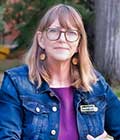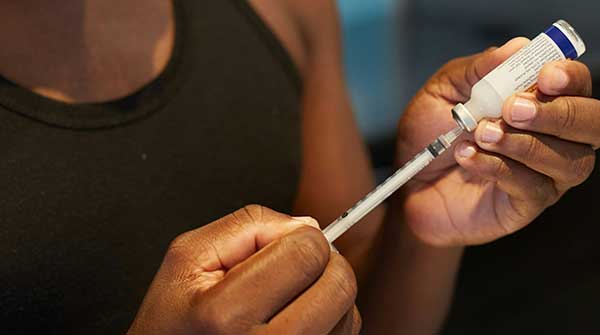Patient-driven research reveals the realities of living with Type 1 diabetes
Kathleen Gibson figures it has cost her about $600,000 to take care of her Type 1 diabetes since she was first diagnosed 29 years ago.
Some of that expense has been covered by her workplace insurance but much of it has been out of pocket. For example, when she finished her nutrition degree, she had $40,000 in student debt, $10,000 of it to pay for her insulin pump and supplies.
“Life with diabetes is hard,” says Gibson. “The full burden is not understood because it’s hard for others to fathom.”
 Kathleen Gibson |
 Jamie Boisvenue |
 Rose Yeung |
 Photo by Sweet Life |
| Related Stories |
| Could a pill cure diabetes?
|
| Breakthrough research offers new hope to diabetes patients
|
| Old antipsychotic drugs may offer a new option to treat Type 2 diabetes
|
That’s why Gibson has volunteered for the past four years as a patient partner on the research team behind the Reshape T1D study at the University of Alberta.
The researchers interviewed 41 adult Albertans living with Type 1 diabetes about the hidden costs of their illness to their mental, physical and financial health, with the goal of recommending changes to clinical practice and improving care.
“I deal with my diabetes 24/7, 365 days a year, and I see my healthcare provider for, let’s say, four hours a year in total,” explains Gibson. “How can they possibly understand what my day-to-day existence is in four hours?”
The research team, made up of four patient partners, four diabetes clinician partners and two academics, is analyzing their qualitative data and plans to publish full results next year.
In the meantime, their preliminary findings are posted on the study website. Aside from the high financial costs, patients reported a lack of co-ordinated care and a gap in mental health support. They also felt that their diagnosis limits their education, career and family planning choices and that both virtual care and peer support can help.
“The primary goal of our study is to provide insight at the clinic level on how people interact with Alberta’s health systems for their Type 1 diabetes,” says scientific lead Jamie Boisvenue, a doctoral candidate in the U of A’s School of Public Health. “If we really want to make change, we have to understand it in the context of the person in the clinic as it’s happening, and, to do that, we need to involve those individuals as co-researchers.”
“We as healthcare providers have a lot of responsibility and a lot of influence,” says principal investigator Rose Yeung, an endocrinologist and associate professor in the U of A’s Faculty of Medicine & Dentistry. “We need to empower patients to understand the reality of their disease so they can manage and cope better, rather than taking their hope away or telling them that they can’t do things that they dream of doing.”
The study’s secondary goal is to demonstrate how community-based, participatory research can fully incorporate patient and clinician perspectives.
“People with lived experience of Type 1 diabetes and healthcare professionals in diabetes care are the experts,” says Boisvenue. “That’s what qualifies them to conduct scientific research – and when you involve them throughout the research process, it enriches the trustworthiness of your research.”
“Being part of this is helping me to amplify my voice,” says Gibson, who was diagnosed with Type 1 diabetes at age 27.
Over the years, she has used insulin pen injections and an insulin pump to control her diabetes, and undergone three islet cell transplants through the Edmonton Protocol. She lives with chronic kidney disease as a complication of the anti-rejection drugs she has to take for the transplants.
Gibson says diabetes has affected not just her health and finances but nearly every aspect of her life. She started out working as a chemist but chose to switch careers after her diagnosis, becoming a registered dietitian and certified diabetes educator. She works with people who have Type 2 diabetes through the First Nations and Inuit Health branch of Indigenous Services Canada.
She never had children because she didn’t want a high-risk pregnancy. She hasn’t travelled as much as she would have liked. Instead, she jokes she “should buy shares in a juice box company” because she has to eat something sweet when her blood sugar goes low, just one of the daily challenges of managing her diabetes.
Gibson says she has had some very supportive clinicians, and she encouraged the Reshape T1D study team to ask participants about their positive as well as their negative experiences. But she has sometimes had to fight for the care she needed.
“I’ve had to be a very strong self-advocate and I’m sure I pissed off some of my healthcare providers by not taking no for an answer,” she says.
Gibson has volunteered for Diabetes Canada (click here to donate) and participates in the Patient Immersion Experience at the U of A, which helps medical students understand what life is like with a chronic illness. She also raises funds for the Diabetes Research Institute Foundation Canada (click here to donate).
Gibson has high hopes that the insights from the Reshape T1D study will help clinicians become more informed and empathetic.
“I hope that healthcare providers will have a better understanding of how they treat people living with Type 1 diabetes and the impact their words have on people’s outcomes,” Gibson says. “It’s about having compassion and offering kindness.”
“We heard from participants that there is sometimes a whole lot of shame and blame. Clinicians ask, ‘Why aren’t your numbers on target?’ without ever asking anything about what else might be going on, like I just got a divorce and that might be why my numbers aren’t on target.”
Yeung and Boisvenue previously helped create an online resource for women with gestational diabetes. They’re excited to use data to drive quality improvement for people with Type 1 as well.
“If we understand what patients are facing in the system of care, we can help them improve their lives by giving access to the best resources and therapies available,” Yeung says.
“It’s been a very humbling experience to have people share such vulnerable stories of their care, and it drives my desire to continue to do this work,” she says. “It was reassuring to hear stories of people who had received exceptional care as well, where people really went above and beyond to ensure patients were safe.”
“What we’re doing is saying to people living with Type 1 diabetes, ‘You’ve told us your stories and we get it, and we want you to see how these pieces can resonate with people who may not live with diabetes,” says Boisvenue.
| By Gillian Rutherford
This article was submitted by the University of Alberta’s Folio online magazine, a Troy Media Editorial Content Provider Partner.
The opinions expressed by our columnists and contributors are theirs alone and do not inherently or expressly reflect the views of our publication.
© Troy Media
Troy Media is an editorial content provider to media outlets and its own hosted community news outlets across Canada.

